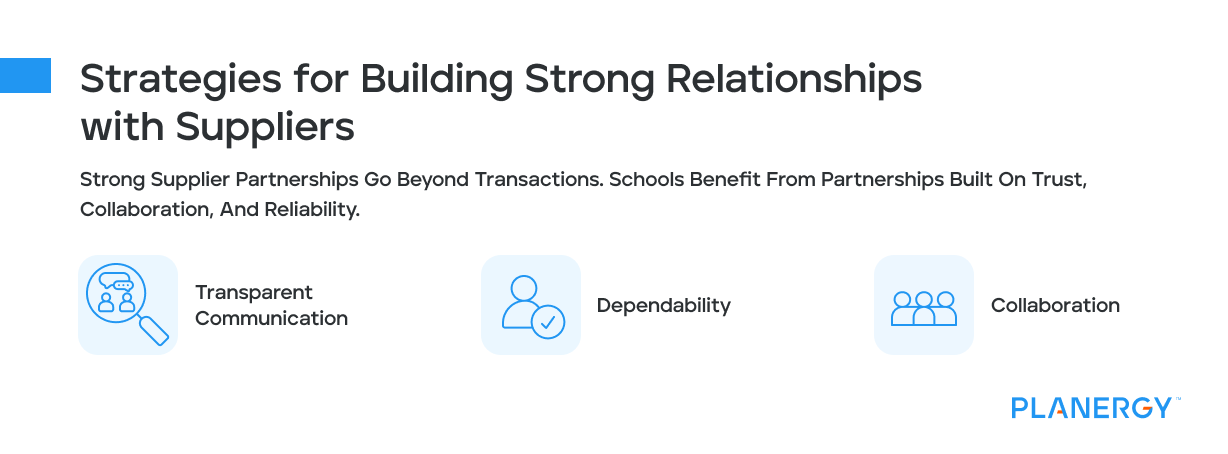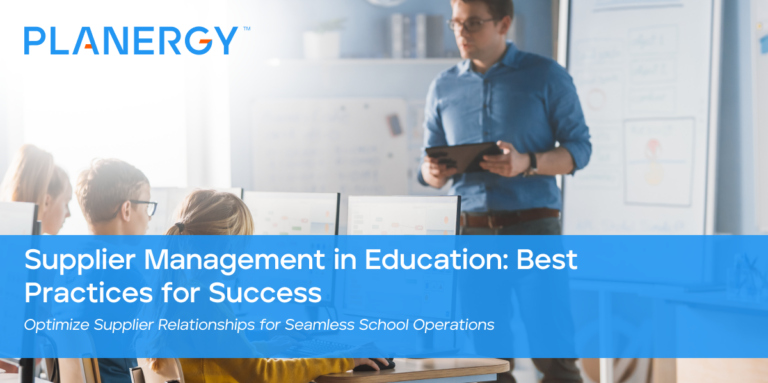Effective supplier management is essential for educational institutions.
Schools rely on vendors for everything—textbooks and classroom supplies, technology, food services, and maintenance.
Managing these suppliers isn’t just about making purchases; it ensures smooth operations, cost savings, and quality education.
Efficient supplier relationships streamline operations, improve resource use, and create better student learning environments.
However, budget restrictions and transparency requirements present challenges.
Tools like PLANERGY help schools overcome these obstacles by automating workflows, tracking spending, and enhancing decision-making.
What is Supplier Management?
Supplier management involves selecting, evaluating, and maintaining supplier relationships to ensure timely delivery of goods and services within budget.
For schools, this ensures classrooms and operational areas remain functional and efficient.
Benefits of Effective Supplier Management

- Operational Continuity: Reliable suppliers reduce delays in delivering classroom essentials or repairs.
- Cost Efficiency: Thoughtful management helps schools meet financial goals by eliminating waste.
- Improved Focus: With fewer disruptions, educators can dedicate more energy to teaching.
Schools thrive when predictable and reliable supply chains foster a stable learning environment.
Key Components of an Effective Supplier Management Strategy for Schools
Developing an effective supplier management system demands careful planning, practical decision-making, and clear processes.
These steps help schools secure reliable vendors while aligning procurement practices with their unique needs.

Supplier Selection
The foundation of your supplier management strategy starts with choosing the right suppliers for the task at hand.
It’s not enough to make decisions on price alone. You must also evaluate vendors for quality, reliability, and overall reputation.
Vendors with a proven track record in meeting deadlines and delivering high-quality goods can keep your classrooms stocked and running smoothly.
Working with trustworthy vendors reduces the risk of late deliveries, inconsistent product quality, and hidden costs.
A reliable supplier of educational materials ensures students have textbooks or laptops on time, preventing learning delays.
Criteria such as customer references, financial stability, and adherence to ethical and sustainability practices should also be considered.
Effective supplier selection ensures resources are used wisely, directly supporting teaching and student development through timely access to what they need.
Contract Management
A well-structured contract clearly defines both parties’ roles, responsibilities, terms, and deliverables.
It minimizes ambiguity and ensures accountability while providing a framework for resolving potential disputes.
Setting clear expectations with contracts allows you to avoid misunderstandings about product specifications, delivery timelines, and payment terms.
For example, explicitly outlining penalties for late deliveries protects you from service disruption.
Contract management also maintains compliance with procurement regulations, which is critical since public schools may face audits.
Clear contracts align supplier performance with your institution’s needs, ensuring contracts prioritize budget constraints, quality standards, and educational requirements.
Performance Monitoring
After contracts are in place, ongoing performance monitoring ensures suppliers deliver the expected value.
The key is tracking the right metrics to spot whether adjustments are necessary.
- Delivery On-Time Percentage: Are deliveries arriving on-time as agreed? What percentage of deliveries have had issues? Are those issues easily explained as one-time incidents, or are they signs of an ongoing problem?
- Product Quality: Are goods and services meeting expectations?
- Cost Control: Are rates consistent with contractual terms?
Inventory Management
Effective procurement isn’t just about buying things to meet your specific needs.
It’s about making sure you have enough items on hand to keep things moving, without tying up too much money in stuff you don’t use quickly.
It’s about streamlining processes so you know what you need and when, and how long your supplies will last.
It’s about benchmarking so you know your economic order quantity, so you never purchase too much or too little of anything.
Communication
Communication goes beyond transactional emails or phone calls to involve ongoing dialogue to address potential issues, refine processes, and review shared goals.
Open communication fosters trust and accountability.
Letting suppliers know about expected order volumes in periods of high demand helps avoid shortages.
Suppliers can, in turn, share insights about product innovations or potential delays to allow schools to plan effectively.v
Regularly scheduled check-ins, feedback sessions, or vendor appreciation initiatives can strengthen collaboration, ensuring both parties work as partners rather than adversaries.
Technology Integration
Integrating digital tools into supplier management processes keeps operations modern, eliminates inefficiencies, and generates valuable insights for data-driven decision-making.
Solutions like PLANERGY simplify workflows and improve accuracy.
Technology automates repetitive tasks like purchase approvals, order tracking, and invoice management, freeing up administrators’ time for strategic planning.
Tools like PLANERGY allow procurement teams to analyze spending patterns, compare supplier performance, and streamline contract renewals—all key to reducing costs and improving supplier relationships.
For example, digital dashboards can track whether suppliers are delivering on time or whether spending is exceeding budget projections.
Cloud-based management software also enables schools to access supplier information round the clock in real-time, ensuring faster resolutions during emergencies.
Procurement professionals need a sleek purchasing process to maximize budgets, which are often limited in the education sector.
Strategies for Building Strong Relationships with Suppliers
Strong supplier partnerships go beyond transactions. Schools benefit from partnerships built on trust, collaboration, and reliability.

Transparent Communication
Express your needs and expectations from the beginning and maintain regular contact with all suppliers. Share timelines, order forecasts and feedback.
Provide suppliers with detailed purchase orders that outline product specifications, expected delivery dates, and special requirements.
Schedule regular check-ins to discuss performance, upcoming needs, and potential challenges.
If you experience a new student enrollment surge, do your best to discuss it early enough to allow suppliers to adjust stock levels accordingly.
Dependability
As you expect your vendors to honor quality standards and delivery schedules, remember your suppliers also rely on you to fulfill your obligations.
Whether it’s timely payments or accurate demand forecasts, honor your commitments to strengthen trust.
Have accounts payable handle invoices on or before the due date to build goodwill.
You may find suppliers are more willing to offer favorable terms to you if you have a reputation for prompt payment.
If you have any change of plan, notify the supplier immediately to allow them to adjust accordingly.
Collaboration
For the best results, you cannot rely on a transactional approach.
If you treat your suppliers as collaborators, they’re involved and feel valued, which makes them more likely to work hard for you.
If you’re planning a major tech upgrade, ask your supplier for recommendations on affordable, but effective hardware solutions.
Be open to suggestions because your vendors bring industry knowledge that you can benefit from.
Offer constructive feedback. Rather than focusing on mistakes, work with the supplier to address the root cause of an issue, then implement corrective measures.
Elevating and Selecting the Right Vendors for Educational Institutions
Decisions should not be solely based on cost, but other factors like quality, reputation, and alignment with institutional values.

- Pricing and Payment Terms: Find vendors who deliver value without compromising quality.
- Reputation and References: Research testimonials and reviews from educational institutions.
- Delivery Timelines: Ensure suppliers can meet your unique scheduling requirements.
- Sustainability Practices: Opt for vendors who support environmentally responsible practices.
Best Practices for Negotiating Contracts in Educational Procurement
Well negotiated contracts provide the groundwork for a successful supplier relationship while ensuring schools get favorable terms.

- Research Market Standards: Understand prevailing market rates and industry norms before entering discussions.
- Define Deliverables Clearly: Ensure all expectations—such as quality standards, timelines, and accountability—are well-documented.
- Prioritize Flexibility: Negotiate terms that allow room for contingencies, like sudden enrollment spikes requiring higher supply orders.
- Ensure Compliance: Stay in line with educational procurement policies and local regulations.
The Role of Technology in Supplier Management for Schools
Adding technology like PLANERGY improves school supplier relationship management through automated workflows, fewer errors, and actionable data insights.
Since artificial intelligence (AI) automation eliminates repetitive tasks, your team can focus on more value-added tasks with their time savings.
The data insights into spend management make spotting cost-saving opportunities easier.
And because cloud-based platforms make supplier information available at any time, your team can access it remotely and keep everything current, which is better for regulatory compliance.
Risk Management in Supplier Relationships
Unforeseen challenges, like a supplier going out of business or supply chain disruptions, can severely affect schools.
Proper risk management protects against these situations.
While you can’t completely eliminate risk, knowing what your risks are is crucial to minimizing the impact of anything that may come along.
- Supplier Diversification: Set yourself up so you’re not overly dependent on a single vendor.
- Contingency Plans: Build alternative options for your most critical supplies.
- Regular Audits: Keep a close eye on supplier financial health and reputation.
Encourage Sustainable Supplier Practices
Focus on sourcing from eco-friendly suppliers and opting for sustainable products where possible.
This means adopting digital solutions to reduce paper use, using energy-efficient tools and recycled materials, and choosing vendors who operate with environmentally sound practices.
Collaborative Procurement
Consider partnering with other schools to purchase goods in bulk, so you can leverage your purchasing power and shared knowledge.
In multi-academy trusts (MATs), this practice is known as gag pooling, where schools pool their resources for the benefit of all members, which helps with budgeting.
You’ll be able to leverage volume discounts for better prices at the unit level, learn from each other’s procurement processes, and reduce the workload overall by sharing administrative tasks.
Training Staff on Vendor Management
No strategy is complete without a capable team to execute it. Staff should have the skills to manage all suppliers responsibly and efficiently.
To build a knowledgeable team, offer regular workshops and training sessions.
Educate staff on procurement policies and industry best practice.
Encourage digital upskilling by introducing (and providing training on) user-friendly platforms like PLANERGY to simplify processes and improve tech proficiency.
An empowered team optimizes procurement and promotes adherence to established policies.
Final Thoughts
Supplier management isn’t just about logistics. It’s a strategic initiative that directly influences educational outcomes.
Schools prioritizing it can capitalize on better resource utilization, operational efficiency, and more substantial student support.
By following best practices, building strong supplier relationships and using technology like PLANERGY, schools can turn procurement challenges into opportunities for lasting growth and success.
There’s no better time to reevaluate your supply chain management strategies and take the first step toward a brighter, more efficient future.




